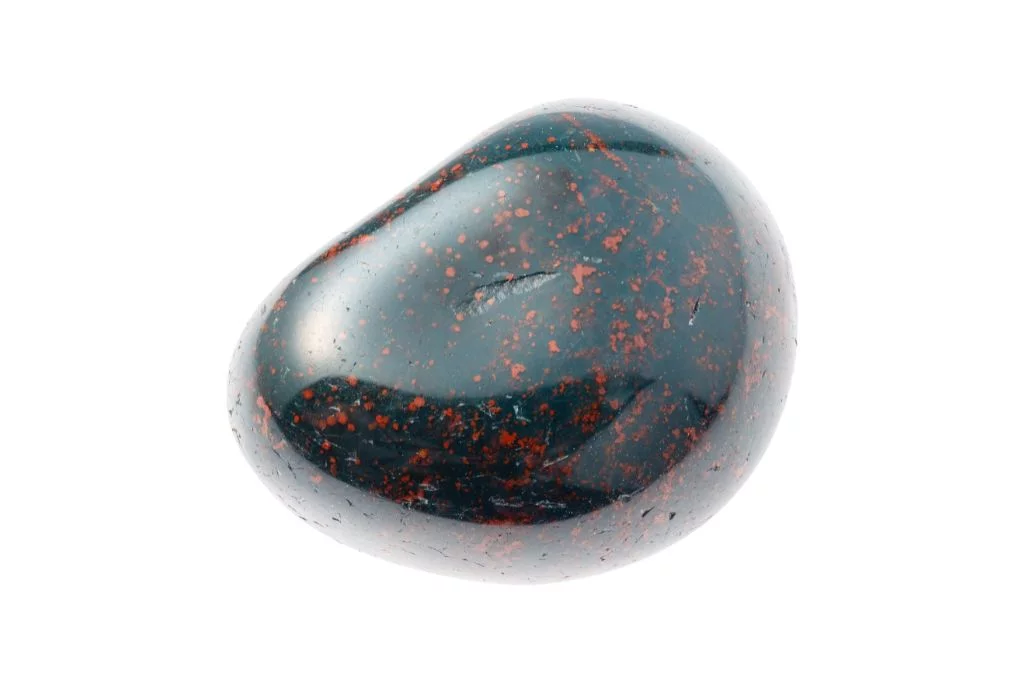The Appearance of Bloodstone
Bloodstone, also known as heliotrope, is a captivating and unique gemstone that immediately catches the eye with its distinctive appearance. This opaque chalcedony quartz is predominantly dark green in color, creating a rich and earthy backdrop. What truly sets bloodstone apart, however, are the vibrant red inclusions scattered throughout the stone.
Color and Patterns
The base color of bloodstone ranges from a deep forest green to a more muted olive tone. This green hue is punctuated by striking spots and splatters of red, which can vary from bright crimson to rusty brown. These red markings are typically jasper or iron oxide inclusions, and their appearance often resembles droplets of blood, hence the stone’s evocative name.
Structure and Texture
Bloodstone has a cryptocrystalline structure, meaning its crystals are so fine that they cannot be distinguished individually, even under magnification. This structure gives the stone a smooth, waxy luster when polished. The gemstone is typically found in massive form, meaning it occurs in large, shapeless aggregates rather than well-formed crystals.
Unique Characteristics
One of the most intriguing aspects of bloodstone is the variation in its red markings. Some specimens display small, evenly distributed spots, while others feature larger, more dramatic splashes of color. In rare cases, the red inclusions may form intricate patterns or even appear to depict scenes or figures, making each bloodstone truly one-of-a-kind. Additionally, some bloodstones may contain yellow or white inclusions, adding further complexity to their appearance.
Historical and Cultural Significance of Bloodstone
Bloodstone, also known as heliotrope, has been revered for centuries across various cultures. Ancient Egyptians believed it held magical powers, often using it in amulets and seals. In Medieval Christianity, the stone was associated with the crucifixion of Christ, with its red spots symbolizing drops of blood. This connection led to its use in carved sculptures depicting religious scenes.
Metaphysical Associations
In metaphysical circles, bloodstone is considered a powerful healing stone. It is thought to purify and detoxify the body, particularly the blood, liver, and kidneys. Many believe it enhances courage, increases mental clarity, and promotes creativity. Bloodstone is also associated with the root and heart chakras, believed to help ground excess energy and balance emotions.
Common Uses and Benefits
Bloodstone is widely used in jewelry, often set in rings, pendants, and bracelets. Crystal healers use it in layouts on the body or as a massage tool. Some people carry bloodstone as a pocket stone for protection and to absorb negative energy. In alternative medicine, it is sometimes used to treat blood disorders, menstrual issues, and to boost the immune system. Modern practitioners may use bloodstone in meditation to enhance focus and intuition.
Traditional and Modern Applications
Traditionally, bloodstone was used as a talisman for athletes to increase strength and stamina. In modern times, it is popular among public speakers and leaders for its alleged ability to increase confidence and eloquence. Some business people keep bloodstone in their offices, believing it attracts abundance and success. In crystal grids, it is often used for protection and to cleanse spaces of negative energy.

